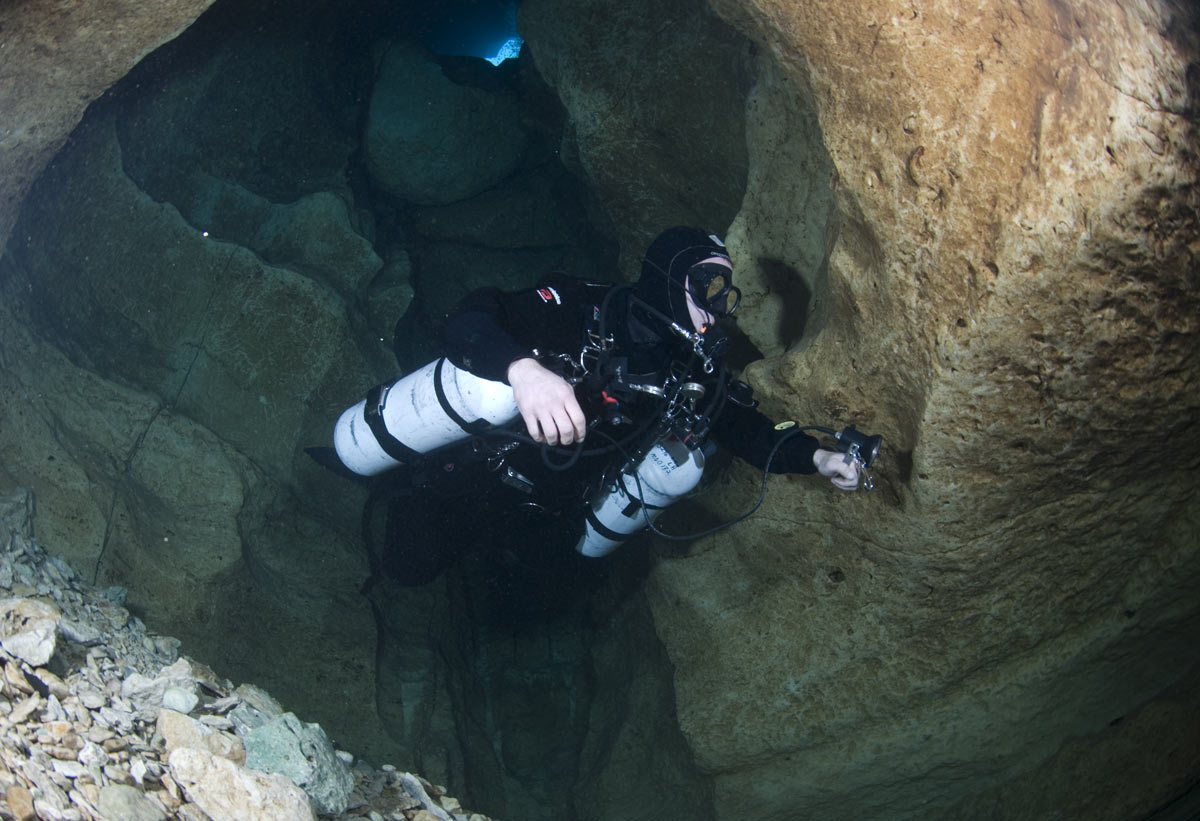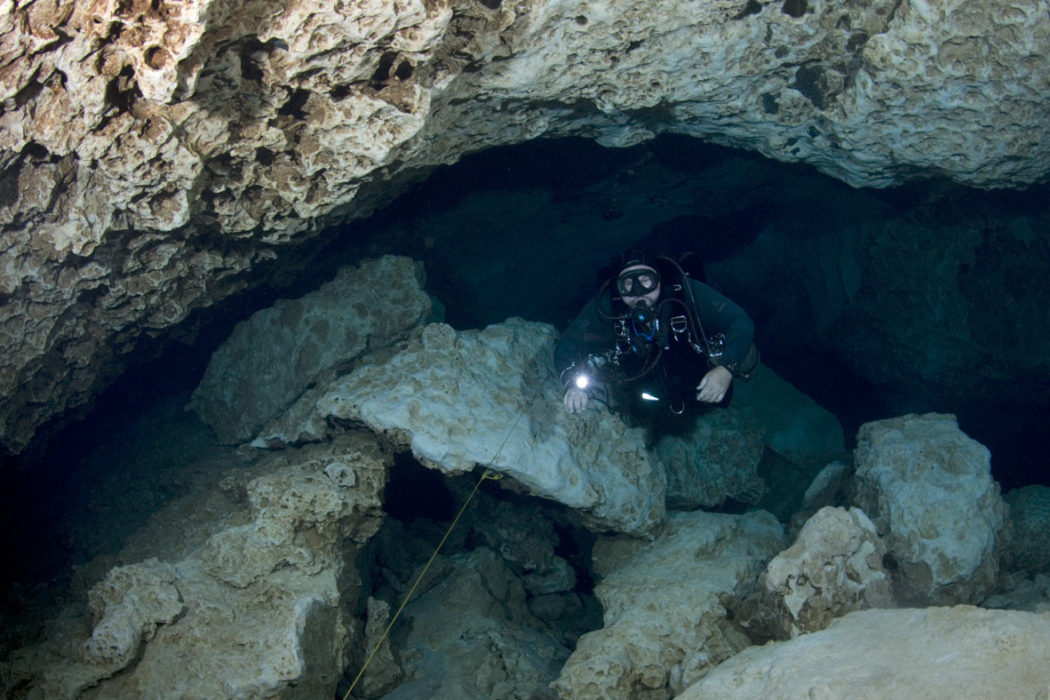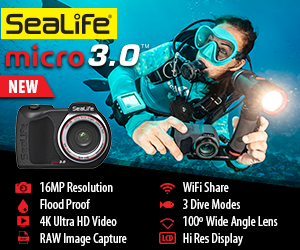Until recently I never gave much thought to getting “cave certified.” I mean, I’ve kind of been everywhere and done (almost) everything in the scuba realm and lived happily ever after. I’ve had many a grand adventure and always felt both challenged by and fulfilled with my diving, so why, after thousands of dives and several decades of exploring coral reefs on five different continents did I all of the sudden have the itch to get cave diving certified?
That’s exactly the question my wife asked, as she recognized all too well that glazed-over, faraway look in my eyes that signaled I’d already made up my mind — and that no amount of “discussing it” would sway me from my new cave quest.
RELATED READ: PEERING INTO UNDERWATER CAVES AND CREVICES
So why cave diving? For starters, I had an intriguing assignment that offered me the chance to photograph the front part of a cave in south Texas. The assignment required that I be qualified to make the dive, which I wasn’t. Honestly, I probably wouldn’t have considered it without that carrot dangled in front of my face. But the second reason is that once I got to reading about what’s required during cavern and cave training it sounded really interesting. I recognized that even a long-in-the-tooth diving dinosaur like me could learn a thing or two — and that cave diving lessons just might make me a better diver even if once the course was done and the assignment bagged I never made another cave dive for the rest of my life.
I found myself feeling anxious and jittery going back into the classroom. And it felt good. I felt invigorated by the newness of it. After a week of training in some Florida panhandle caverns and caves I can honestly say I enjoyed the whole experience, from start to finish. And just as I suspected, I came away with the knowledge that my cave diving training will indeed benefit me in open water.
Here are are eight key lessons every sport diver can learn from cave diving.
Lesson 1: There is no substitute for thorough education and proper training.
This is true of any endeavor, be it a career or a sport, especially one that comes with a list of risks that include death. Diving gets riskier when it takes place in an overhead environment. Cave diving instructors make sure to get this point across to their students.
Before entering any overhead environment, make sure you receive proper training and are equipped for the environment. Most cave fatalities are due to either a lack of cave training or if cave certified, diving beyond the level of training.
Cavern and cave diving should be approached conservatively. This means you should advance your diving challenges only after completing the training required for that type of dive. Several training agencies offer progressive cavern and cave training, such as Intro to Cavern, Cavern Diver, Intro to Cave, Full Cave and Advanced Cave Diver. Each course builds upon the other in a stair-step fashion that introduces the diver to new techniques and environments without putting him or her in a situation beyond their current level of training.
Two essential skills for cave training, which are pertinent to all divers: mastering buoyancy control and control of body positioning. Precision buoyancy control is critical in cave diving. The three biggest concerns are silt outs, damage to the environment, and conserving energy and air. Cave divers become masters of buoyancy control. Every dive is a control clinic. Every open water recreational diver should strive to master buoyancy control for similar reasons: conservation of vulnerable environments and for safety. Perfecting buoyancy control means you trim with little thought and no stress. Body posture is also critical in caves. It not only reduces drag and lessens air consumption but also lessens risks of silting caused by accidental contact with cave walls or the bottom. Open-water divers who take the time to properly trim out their gear and optimize their body posture while finning will realize the benefits of a more enjoyable dive with less effort.
Lesson 2: Every dive deserves planning and preparation.
As the complexity of a dive increases and the challenge factor goes up, so does the level of planning and preparation you’ll need to safely make the dive. Don’t ever use experience as an excuse for not planning. Cave divers and other technical divers always go through a systematic series of checklists and what-ifs as part of their dive planning and preparation. Good recreational divers should also plan out their dives in enough detail to consider both the worst-case scenario at depth and on the surface.
Planning and preparation also include making predive checks for proper functionality. Always check both second stages and, like cave divers, on each dive consider doing an “S Drill.” The “S” stands for safety and includes practicing an emergency air-sharing exercise at a shallow depth. In cave diving, proper equipment configuration is not an option. It’s crucial to have the needed equipment redundancies to safely enter an overhead environment. Savvy rec divers should think along the same lines even though risk profiles are far different. What if you are making a drift dive off Palancar Reef in Cozumel at a depth of 100 feet (30 m) and while passing through a tunnel your low-pressure hose snags the reef and begins leaking? Do you have a personal alternate air supply or are you relying on your buddy? Either way may be acceptable but it’s something that should be discussed before the dive.
Remember that “S-Drill”? Another nugget of knowledge from cave training: Dispel the simple notion that more equipment is always better. Every piece of equipment you wear must have a clear purpose for that dive. If any piece of gear is deemed nonessential for safe execution of the dive or not needed to achieve your goal for the dive, leave it behind. Unessential gear is a minus on a dive, not a plus.

Cavern and cave diving should be practiced conservatively. This means you should advance your diving challenges only after completing the training required for that type of dive. Photo by Jesse Cancelmo.
Lesson 3: Personally reconfirm the gas content in your cylinder(s).
The increased availability of nitrox, along with the steady increase in trimix use by technical divers means gas supply checks are much more important than they were in the past. Too little oxygen — or too much — can cause a diving fatality. Every tank with nitrox or trimix requires an O2 check by the user prior to the dive. Not unlike luggage checks at the airport, if your tank(s) was out of your possession since you last verified its contents, consider the gas “suspect” and reanalyze the content before you dive. The tank label should show at a minimum the content (mix), MOD (maximum safe depth), date and name or initials of the person verifying the gas mix. Don’t ever rely on a label and sign-off. This important verification also applies to deco tanks, since they may contain 100 percent oxygen. The requirement for the user to do the “check and sign-off” is gospel in the cave and other technical diving worlds. No diver should lose his or her life because of a mismarked tank.
Lesson 4: Be familiar enough with your gear to dive with your eyes closed.
Are you familiar enough with your equipment configuration that you can make a buoyancy adjustment or a second-stage switch with your eyes shut? If no, here’s an opportunity for you to become a better diver. One of the more critical skills in cave diving is dealing with silt outs. In severe situations, when visibility goes to zero, cave divers are trained to function entirely “by feel.” This includes all gear functions, communications and, if needed, search activities using lines and reels. Although rare, recreational divers can also suddenly encounter situations with very low or even near-zero visibility. Having the skills and mindset for functioning by feel goes a long way in minimizing the stress when faced with an unexpected reduction in visibility. This is a skill that can be practiced in a swimming pool.
Lesson 5: Practice Problem Solving at Depth.
Any cave diver will attest to the truism that education and training gets you only so far. When push comes to shove, experience and sound decision-making is what usually makes or breaks solving a difficult problem. This is why it’s so important to always keep a clear head when diving. One of the big differences between open water and overhead environments is so many problems that may occur at depth in open water can be dealt with by simply aborting the dive and surfacing. In an overhead environment you can’t just ascend. You have no choice but to deal with the problem and resolve it in place altogether, or to a degree that allows a safe exit from the cave. This is where training, experience, a clear head, and using a calm, systematic approach makes all the difference.
Cave training involves a host of problem-solving drills that include mask flooding, loss of visibility and entanglement. At even the beginner level, sport divers can enhance their skills by practicing tasks as simple as mask removal and clearing at depth, or air sharing. Considering spending a few minutes on each dive thinking about and acting out a “what if” scenario. (Discuss this with your buddy and the dive leader ahead of time and come up with a signal for “simulated problem” so as not to alarm other divers unnecessarily.) You’ll likely find that by practicing problem solving on every dive you will increase your confidence in your ability to handle a real problem if it arises.
Lesson 6: Improve your communication skills.
Effective communication during a cave dive can mean the difference between life and death. The Intro to Cavern Diver course includes drills for skills covering all types of in-water communication: hands, light, touch/feel, and use of a wet writing pad. Sport divers can definitely better their skill sets by improving and tuning their communication abilities. What diver hasn’t been frustrated on a dive that involved a lack of communication between buddies?
The best approach is to practice communications more on your dives — before you put a regulator in your mouth and submerge. Most divers know fundamental hand signals, such as “out of air,” “where’s the boat?” and “let’s go up” but are you doing your best to maintain a close connection with your buddy by using hand signals frequently during your dive? Do you use signals for “slow your ascent” or “hold your depth at safety stop”? Signaling skills must be practiced. When your buddy or another diver signals you by hand or with a light, always signal back an acknowledgement, as communication isn’t complete until the signal is given and receipt is acknowledged.
Wet notes or a dive slate are some of the most underused tools in recreational diving. These writing devices can greatly enhance your ability to better communicate on a dive. Wet notes enable you to clarify safety-related information (e.g., need to go to contingency dive plan) or provide detailed information about the environment or an animal encounter that could never be done adequately using hand signals.

Buddymanship is vital to cavern and cave training. Before each dive, check your own and your buddy’s gear. Photo by Jesse Cancelmo.
Lesson 7: Embrace the principles of good buddymanship.
Sure, some sport divers get by with the “SOB” (same ocean buddy) principle, but that just doesn’t fly in the cave diving community. Buddymanship starts with buddies learning about each other on land. When you know about your buddy’s experience, knowledge and skills, you will be a better buddy. It’s a given for recreational, cave and other technical divers that you never dive beyond the capability of the least skilled or experienced diver on the team. It always pays to be honest and conservative assessing yourself and your own limits of training and experience. Bravado has no place underwater in an open environment let alone an overhead situation.
Before every dive thoroughly check your equipment for readiness and functionality and then do a check and familiarization of your buddy’s gear. Do a comprehensive check from fin to face. Check for twisted straps or loose hoses and be aware of your buddy’s buoyancy controls and placement of octopus second stage. Review the dive plan and discuss who does what, and how, in case there’s a need to share air. Once in the water, check each other for any air leaks.
Cave divers are taught to always respect a diver who signals to turn or end a dive. The “no recrimination for doing so” is a fundamental in cave diving. Credit the diver who thumbs or turns a dive to be an honest diver who knows his or her limits. Consider this diver a good example for maintaining utmost safety on a dive. Another important cave lesson is that you and your buddy have a responsibility to understand the dive plan, any back-up plans for the dive and know what to do in an emergency. Never relinquish that responsibility and never blindly follow another diver into an unfamiliar environment or condition.
Lesson 8: Stress management is a skill.
Every diver deals with stressful situations from time to time. Dives don’t always go as planned and you never know what excitement you may encounter in the underwater realm. Actually, maintaining just enough stress to banish mental complacency can be a good thing. But how one manages an increasingly stressful situation can mean the difference between an overall successful and enjoyable dive versus possible panic. In an open-water dive a panicked diver will fight to go straight up; in an overhead environment there is no going straight up. Proactive divers can avoid many of the sources of stress by getting proper training, honing their dive skills, using the right equipment configuration, and always planning their dives. Thorough planning and smart execution will minimize the chances of unexpected and stressful task loading situations, as these lead to trouble. Overhead diving experts will tell you that recognizing stress is the first step to controlling it. If during a dive you ever feel increasingly uncomfortable for any reason whatsoever, the smartest course of action is to end the dive.
Sport divers and cavers alike should repeat the same mantra for controlling stress: stop, breathe, think and act. In a stressful situation, the first things to do are to stop moving and check your gas supply. If, for example, you get tangled in monofilament line on a shipwreck and start getting stressed out, stop all efforts to swim or free yourself. Then confirm you have plenty of gas, and continue to relax for a minute and get your breathing under control before trying to do anything more. With a few slow, deep breaths you can stabilize your breathing and then use your training to think your way through the problem and solve it in a methodical manner. You can determine where you are snagged and you can find your cutting device with your eyes shut because you’ve practiced. Such confidence allows you to calmly cut yourself free. With a line entanglement in a cave where there is risk for further entanglement and silt out, the most appropriate action may be to signal your buddy to have him or her more easily untangle or cut you free.
It’s been said that some of the best divers in the water are cave-trained divers. I can tell you from experience, it’s true. Even if you don’t have a burning desire to become a famous cave explorer, cavern and cave training can help you improve your diving skills for safer, more enjoyable sport diving.






